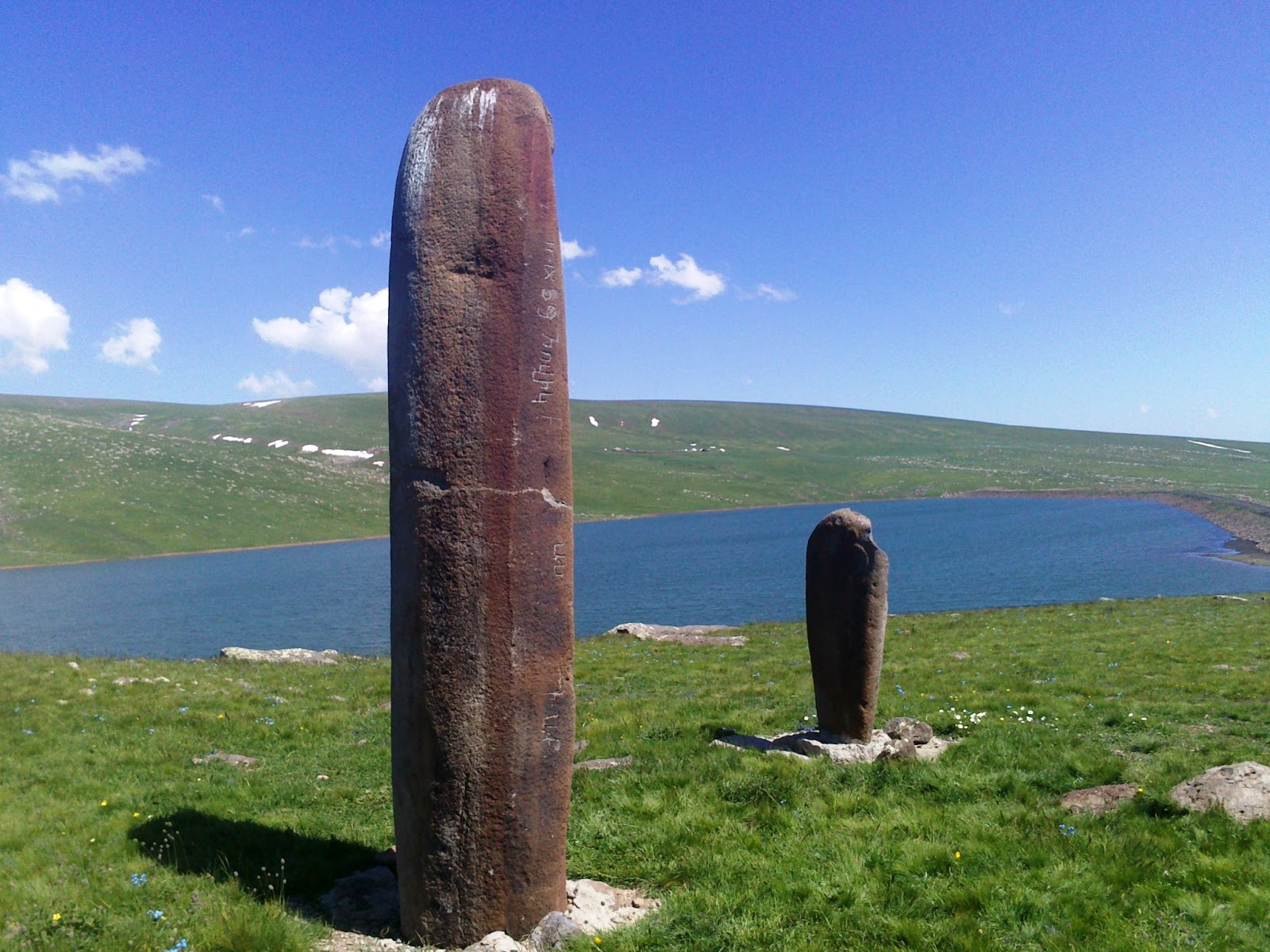Armenia’s ‘dragon stones’ inscribed on UNESCO World Heritage Tentative List
- (0)

The Vishaps and the Cultural Landscape of Tirinkatar have been included in the Tentative List of the UNESCO’s World Heritage List. The decision was made at the the session of the the World Heritage Committee in New Delhi, India.
Harutyun Vanyan, the head of the Department of Protection of Historical and Cultural Monuments from of the Ministry of Education, Science, Culture and Sports, is participating as the coordinator of the convention.
In the high mountains of Armenia, unique archaeological monuments have been preserved to our days, which are traditionally called by the people “vishap” (Armenian for “dragon”). These are two to five meter high basalt stelae, which are unique among the stone stelae of the ancient world because of their unparalleled animal iconography and peculiar locations. Vishaps are either sculpted in the form of a fish (the piscis kind) or carved as if a bovine hide with head and extremities was draped over them (the vellus kind). Sometimes both iconographies are combined (the hybrida kind).
Currently ca. 150 examples of these monuments are known. As a rule, they are located in secluded, water-rich, high altitude meadows in the unforested mountains, ca. 1200-3200 m above sea level. Their highest concentration (ca. 120 examples) has been detected on Mt. Aragats, in the Geghama, Sevan, Vardenis and Syunik mountains of Armenia. The limits of their macro-regional distribution are the Lake Van region in the south, the Trialeti mountain range in the north, the Erzurum region in the west and the Sevan mountain range in the east.
The vellus vishaps are the most numerous ones and they are distributed more or less equally across the macro-region. Vishaps of the hybrida type are the rarest and they are so far confined to the south-west of the Geghama mountains in Armenia. Vishaps of the piscis kind are currently lacking in the westernmost parts of the macro-region. Since the iconography of vishaps is unique, standardized and very specific, their large-scale distribution pattern testifies to the existence of a symbolic and religious common background shared by social groups across the entire region at the time of their erection.
The most significant high altitude site with vishaps and related archaeological monuments is Tirinkatar (Armenian for “Height of the God Tir”). It is an over 370 ha vast archaeological site located on the southern slopes of Mt. Aragats, at an altitude of ca. 2700-3100 m above sea level. Also known by local pastoralist communities as “Karmir Sar” (Armenian for “Red Hill”), it is a stunning summer pasture, rich in grass and water, with spectacular views both of the Mt. Aragats peak and Mt. Ararat.
The archaeological site as such was unknown to the scientific community until recent years, although the surrounding area is mentioned already a century ago by Armenian archaeologists Ashkharbek Kalantar and Grigor Ghapantsyan. In their studies of prehistoric water management systems on Mt. Aragats, they highlighted the importance of “Twelve canals” situated immediately east of Tirinkatar, within the gorge of the river Amberd to divert the river water to foothill villages and their summer pastures. Neither of the two early authors appears to have been aware of the existence of the archaeological site itself, located just above the source of this canal system. In the foothill town of Ashtarak, however, Ghapantsyan did hear and record stories about a certain “Maiden’s Sanctuary”, which appears in those legends as a sacred place connected with the Armenian deity Ara. Ghapantsyan was told that at the site there was “a stone throne with stone chairs,” and other stone images. Today we know that the “Maiden’s Sanctuary” is part of the wider archaeological site of Tirinkatar, first documented by the Armenian-Italian-German team in 2012.
Since that year, systematic surveys and excavations have been carried out in the site by the expedition directed by Dr. Arsen Bobokhyan (Institute of Archaeology and Ethnography of the National Academy of Sciences of Armenia), Dr. Pavol Hnila (Free University of Berlin) and Dr. Alessandra Gilibert (Ca’ Foscari University of Venice). Archaeological data collected from excavated contexts indicate that Tirinkatar was visited and used for campsite activities at least from the Neolithic period, i.e. from the end of the 6th millennium BC onwards. At least since the Chalcolithic period, around 4000 BC, the site was also used for cultic purposes, which were centred on a variety of megalithic monuments, including an extraordinary number of vishaps. During the 3rd to the end of the 2nd millennia BC, other archaeological features were added, including large aggregated cell structures, circular stone structures commonly termed “cromlechs”, circular structures with a stone filling and an inner stone chamber, commonly termed “giant’s houses”, as well as barrows and petroglyphs. In addition to the archaeological monuments, there are also modern loci of religious activities and cult, such as the “Maiden’s Sanctuary”, fields of “dream stones” (tower-like structures constructed by dry stacking of stones and made by people of faith for the purpose of fulfilling their wishes), tombs, etc.
Vishaps are the earliest examples of figurative monumental art in the Caucasus region. They are elaborated on four sides and therefore can also be considered one of the earliest examples of monumental statues in the world. The uniqueness of these monuments is also revealed in their geographical location and iconography, which are very specific and do not have parallels in the ancient world. Vishaps also represent one of the earliest manifestations of organized and complex cult.
The site of Tirinkatar contains the largest accumulation of vishaps (12 statues), being one of the highest archaeological complexes known in the world. It is an exceptional manifestation of early seasonal settlement and domestication of a high mountainous area, as well as of an organized and constantly evolving cultural landscape, a living palimpsest and material archive of millennia of collective spiritual practices. Similar high altitude archaeological sites in other parts of the world are known from the Andes and Himalayas and are dated back from the Late Bronze Age to the Medieval period (e.g. Machu Picchu, Tiwanaku, Chavin de Huantar), while Tirinkatar was used as early as the Neolithic period (6th millennium BC), gradually turning into a major cult center during the Chalcolithic period (end of 5th millennium BC) and into a pastoralist and funerary center during the Bronze Age (3rd and 2nd millennia BC).
The archaeological site clusters around the vishaps, together with other archaeological features as ritual platforms, giant’s houses, cromlechs, petroglyphs, etc., represent one of the earliest and unique cultic systems typical for the Armenian Highland. The complex of Tirinkatar demonstrates how religious practice and so the management of collective memory influenced the formation of early identities and became one of the primary means for uniting communities and organizing the economy (irrigation, herding, seasonal migrations). It is not an accident, that the largest accumulation of vishaps ever found at a single site is documented just at Tirinkatar, indicating that the site was the main cult center of the corresponding society.
The outstanding universal value of the site further lies in the fact that it epitomizes one of the earliest monumental art, earliest cult places, and earliest remains of seasonal pastoralism in the high mountains – not only for the South Caucasus but far beyond. The exceptionally high density of archaeological features still preserved on the surface reveals continuity of human activities over millennia and thus the existence of a rich cultural landscape in the high mountains – a zone that archaeology has only recently discovered and that remains globally underexplored.
Moreover, Tirinkatar is still a living place of pilgrimage. At the highest point of the site, on top of a red pumice hill, the “Maiden’s Sanctuary”, built on a prehistoric megalithic structure and surrounded by memorial pillars and graves, is regularly visited by pilgrims of different faiths, and stands out as a unique example of shared sacred site, where multiple religious communities have created a locus of encounter. There, both the Christian Armenians and Yazidis come to say prayers and perform archaic rituals and sacrifices, bringing people together through sharing space for diverse devotional practices in mutual respect. Compellingly, these devotional practices sometimes also involve the vishaps and other prehistoric megalithic structures.
In addition to the rituals that are still being performed in the area, people are also engaged in seasonal animal husbandry, just like in prehistoric times. In this sense, Tirinkatar represents an outstanding and pristine environment that has preserved the cultural memory of thousands of years.


















